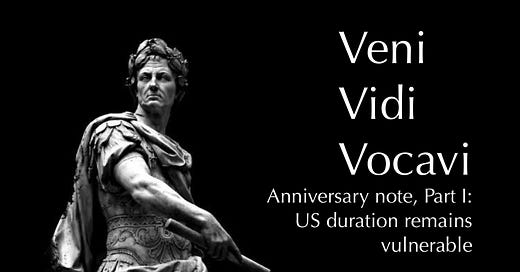It doesn’t always work out this way, so I will be unabashed in claiming eight triumphs on the first anniversary of Thematic Markets: (1) The Fed remained aggressive in withdrawing accommodation; (2) r* is much higher than the consensus thought, so no recession manifest; (3) US term premia were too low, making the yield curve vulnerable to a bear steepening; (4) the dollar would remain strong despite a tactical sell off; (5) equities offered upside this year; (6) the supposed US “banking crisis” was a tempest in a teapot; (7) markets’ hysterical reaction to it represented an exceptional Opportunity (which netted over 100bps of rates profit for Thematic Markets’ subscribers who acted); and (8) the decade-old US capex boom would continue to flourish under the powerful drive of Localization. I might claim another – that inflation would remain sticky on the way down – based on sustained firm core inflation but I should probably wait until next year to claim full victory (and besides, it would be obscene to claim more than twice as many triumphs as Cæsar).
Yet, my Magic Eight Ball hasn’t been foolproof. I expected more macro-credit volatility to manifest this year (Debt perceptions versus reality), and while the year isn’t over, the currency of one of the riskiest macro credits under my analysis, Brazil, has held remarkably firm even as President Lula abandoned fiscal restraint and the Banco Central do Brasil cut rates. Worse, my analysis neglected to mention one of the more obvious potential casualties of rising interest rates after a decade of Quantitative Easing (QE): banks (Did QE cause bank failures?). While I was quick to dismiss a US banking crisis, I fingered European banks as far more likely to yield a systemic crisis that has yet to show itself.
In this two part anniversary series I address the extent to which markets have fully incorporated my triumphs (they have not), whether I will be vindicated in my predictions that have fared less well (of course), and most importantly where value lies. I devote Part I to an update of my views on the US rates curve given their primacy in pricing all other assets and rates markets. After more Fed hikes, a sharp repricing of markets’ assessment of their sustainability, a US debt downgrade, and a better-late-than-never Jackson Hole debate on r*, have markets fully incorporated both the risk neutral rates and term premia that I expect? In Part II, I shift my focus to a selection of international peers of the US: how has the rise in the US rates structure affected and compared to others, and of course are those shifts justified and complete?



